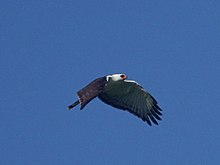Black-and-white hawk-eagle
| Black-and-white hawk-eagle | |
|---|---|

| |
| Scientific classification | |
| Domain: | Eukaryota |
| Kingdom: | Animalia |
| Phylum: | Chordata |
| Class: | Aves |
| Order: | Accipitriformes |
| Family: | Accipitridae |
| Genus: | Spizaetus |
| Species: | S. melanoleucus
|
| Binomial name | |
| Spizaetus melanoleucus (Vieillot, 1816)
| |

| |
| Synonyms | |
|
Buteo melanoleucus Vieillot, 1816 | |
The black-and-white hawk-eagle (Spizaetus melanoleucus, formerly Spizastur melanoleucus) is a
Description

As its name suggests, this is a black and white eagle, resembling the small typical eagles sometimes separated in "
The sexes are alike in color, but the female is larger. Immature birds have pale edges on the upper wing coverts and some brownish-grey feathers on the back.[3]
The black-and-white hawk-eagle is hard to confuse with any other bird in its range with the exception of juvenile Grey-headed Kites. These birds are known to mimic several species of hawk-eagles.[4] The black-faced hawk (Leucopternis melanops) is very similar in overall coloration, but it is much smaller and has a black tail with a single bold white bar in the middle. The ornate hawk-eagle (Spizaetus ornatus), presumably a very close relative of S. melanoleucus, looks quite similar when young. However, the wings, back and tail are much lighter in young S. ornatus, and they do not have the black eye-ring.[3]
Distribution and ecology
This species occurs from
Its natural
The food of this
Its preferred hunting technique is to soar high until it has spotted suitable prey, and then dive down on it, usually right into the

It nests in the forest canopy, building a stick nest high up in exposed trees on ridges and similar locations, from where good hunting grounds can be watched. Detailed observations on its nesting habits are escarce. In Brazil, researchers found and described a nest in 2006 in Southeast Brazil,
There is a general lack of information on the black-and-white hawk-eagle's movements and population status. Each bird seems to require a hunting territory of about 3,500 acres (1,400 hectares) at least. While the variety of habitat types in which it is found suggests that it is not particularly susceptible to changes in land use, it is apparently still a rare and local species almost anywhere in its range. The
Taxonomy and systematics
This species is often placed in the
confusion, which has largely gone unnoticed however:Originally, the name Spizaetus melanoleucus was given by Louis Pierre Vieillot to the black-chested buzzard-eagle in 1819, while the black-and-white hawk-eagle had been described in 1816 by the very same scientist as Buteo melanoleucus. The former species was placed in Geranoaetus – also a monotypic genus – in 1844, while the black-and-white hawk-eagle had been moved out of Buteo and into Spizastur a few years earlier.[3][12]
Thus, the identical
As the black-and-white hawk-eagle has not been placed in Buteo since long, Article 59.3 of the
References
- ^ . Retrieved 12 November 2021.
- ^ "Black-and-white Hawk-Eagle | Whitehawk Birding Blog". 9 July 2020. Retrieved 9 July 2020.
- ^ ISBN 84-87334-15-6
- ^ Menq, William (2013). "Mimicry in birds of prey" (PDF). whitehawkbirding.com.
- ^ a b Zorzin, Giancarlo; Carvalho, Carlos Eduardo Alencar; de Carvalho Filho, Eduardo Pio Mendes & Canuto, Marcus (2006). "Novos registros de Falconiformes raros e ameaçados para o estado de Minas Gerais" [New records of rare and threatened Falconiformes for the state of Minas Gerais] (PDF). Revista Brasileira de Ornitologia (in Portuguese and English). 14 (4): 417–421. Archived from the original (PDF) on 2 November 2010. Retrieved 30 October 2008.
- ^ a b Canuto, Marcus (2008). "First Description of the Nest of the Black-and-White Hawk Eagle (Spizaetus melanoleucus) in the Brazilian Atlantic Rainforest, Southeast Brazil" (PDF). whitehawkbirding.com.
- ^ a b Strewe, Ralf & Navarro, Cristobal (2004). "New and noteworthy records of birds from the Sierra Nevada de Santa Marta region, north-eastern Colombia" (PDF). Bulletin of the British Ornithologists' Club. 124 (1): 38–51. Archived from the original (PDF) on 31 December 2005.
- ^ a b Ferguson-Lees, J. & Christie, D.A. & Franklin, K. & Mead, D. & Burton, P.. (2001). Raptors of the world. Helm Identification Guides.
- ^ a b Olmos, Fábio; Pacheco, José Fernando & Silveira, Luís Fábio (2006). "Notas sobre aves de rapina (Cathartidae, Acciptridae e Falconidae) brasileiras" [Notes on Brazilian birds of prey] (PDF). Revista Brasileira de Ornitologia (in Portuguese and English). 14 (4): 401–404. Archived from the original (PDF) on 17 December 2008.
- ^ Phillips, Ryan (2009). "Studying Hawk-Eagles in Belize" (PDF). Archived from the original (PDF) on 31 January 2021. Retrieved 9 July 2020.
- .
- ISBN 84-87334-15-6
- JSTOR 4076880.
- Field Mus. Nat. Hist. Zool. Ser. 13 (Part 1(4)): 144–148.
- JSTOR 1365146.
- ISBN 0-85301-006-4
Further reading
- Amorim, James Faraco & Piacentini, Vítor de Queiroz (2006): Novos registros de aves raras em Santa Catarina, Sul do Brasil, incluindo os primeiros registros documentados de algumas espécies para o Estado [New records of rare birds, and first reports of some species, in the state of Santa Catarina, southern Brazil]. Revista Brasileira de Ornitologia 14(2): 145–149 [Portuguese with English abstract]. PDF fulltext Electronic supplement

